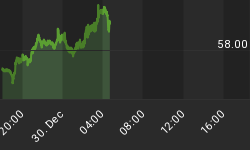The Wall Street Journal's cover story on September 8 boldly proclaimed "Fed Prepares to Act". The article hinted that 'Operation Twist' may be in the works (more on that below). Can you imagine the market's reaction to a headline like that in the late 1990s when the Fed was looked at as some kind of miracle worker? The S&P 500 futures would have popped in the morning and inflation-protection assets would have had a strong open. On the morning of said Wall Street Journal article, the markets barely took notice of possible Fed action. This is clear evidence the markets no longer place central bankers on the miracle worker's pedestal. It also shows fear of debt-induced deflationary outcomes is now outweighing the fear of inflation. These are significant and dangerous shifts for the market's risk/reward profile. If this shift continues, stocks (SPY) and commodities (DBC) may experience further, and rapid declines in the next six months, if not much sooner. We added to our short positions (SH) on August 8.

From a technical perspective, every long-term sell signal we outlined in this September 5 video remains in place. If you have capital at risk in the markets, it is well worth your time to review these clear and observable signals that are similar to those that were in place in 2000 and early 2008. As noted in the excerpts from a recent Bloomberg article below, policymakers are using standard recession fighting tools in the present day; tools which are not appropriate for the long-term structural problems we face.
Pacific Investment Management Co.'s Mohamed El-Erian said the U.S. faces "serious" economic challenges, including lagging housing and labor markets, that will prove resistant to Federal Reserve stimulus efforts.
"You simply can't overcome these impediments," said El- Erian, chief executive and co-chief investment officer at Newport Beach, California-based Pimco, manager of the world's biggest bond fund. "These are structural issues and require structural solutions."
"The key issue any risk manager faces today is that too many parameters have become variables," El-Erian said. "A cyclical mindset is not sufficient given the world we live in," he said. " You need to think structurally."
If you are hoping the Fed will ride to the rescue on the 'Operation Twist' horse, you may be disappointed. In October 2010, we postulated the Fed's second quantitative easing program (QE2) was designed to inflate asset prices, which is exactly what it did (temporarily). QE2 flooded the financial system with freshly printed U.S. dollars - it was pure money printing, which increased the money supply. 'Operation Twist', where the Fed sells short-maturity bonds and uses the proceeds to buy longer maturity bonds, will not increase the amount of dollars in the financial system, which is a stark contrast to QE2. 'Operation Twist' is like shuffling your bond portfolio on the deck of the economic Titanic; it points to a Fed that is running out of options, especially politically correct options, to stimulate the economy. We noted on August 19 that QE2 winners (silver (SLV), energy stocks (XLE), etc.) are not forecasting a miracle stick save form the Fed; nothing has changed in the price/volume action of those assets to change our stance.
As of the close on August 8, the S&P 500's recent rally looks like a typical retracement rally, or bear market rally within a downtrend. Traders watch retracement levels which stood at 1,231 and 1,204 (see orange and purple text below).

A recent Bloomberg story should be a wake-up call for all of us to take the problems in Europe very seriously:
Credit-default swaps on Greek government debt surged to a record, signaling a 91 percent chance the nation will fail to meet debt commitments, after its economy shrank more than previously reported.
"It's a combination of Greece continuing to disappoint and probably a growing realization among politicians that they're throwing good money after bad," said Gary Jenkins, head of fixed income at Evolution Securities Ltd. in London. "They've finally woken up to the fact that they're not going to get this money back."
A clear break of short-term retracement levels, shown below at 1,186 (point B below) and 1,177 (point C) on the S&P 500, would be another short-term red flag for asset prices.

We will remain defensive/bearish until we see improvement in the fundamentals (mainly Europe) and the technicals. Keeping an open mind about a possible change in the market's tone is always a good idea.
















